Southern Cross Education Institute: Mental Health Nursing Assignment
VerifiedAdded on 2022/12/12
|35
|7030
|144
Homework Assignment
AI Summary
This document presents a student's assessment for the HLTENN009 unit, focusing on implementing and monitoring care for individuals with mental health conditions. The assessment includes answers to questions about mental health nursing theories (specifically King's Theory of Goal Attainment), social, psychological, cognitive, and physical factors associated with mental health conditions, and the perspectives of clients and carers in mental health care. The document also includes the assessment record, student declarations, and resource materials, demonstrating a comprehensive understanding of the unit's learning objectives and assessment criteria. The assignment is designed to assess the student's ability to apply theoretical knowledge to practical scenarios within a nursing context, emphasizing the importance of holistic and patient-centered care.
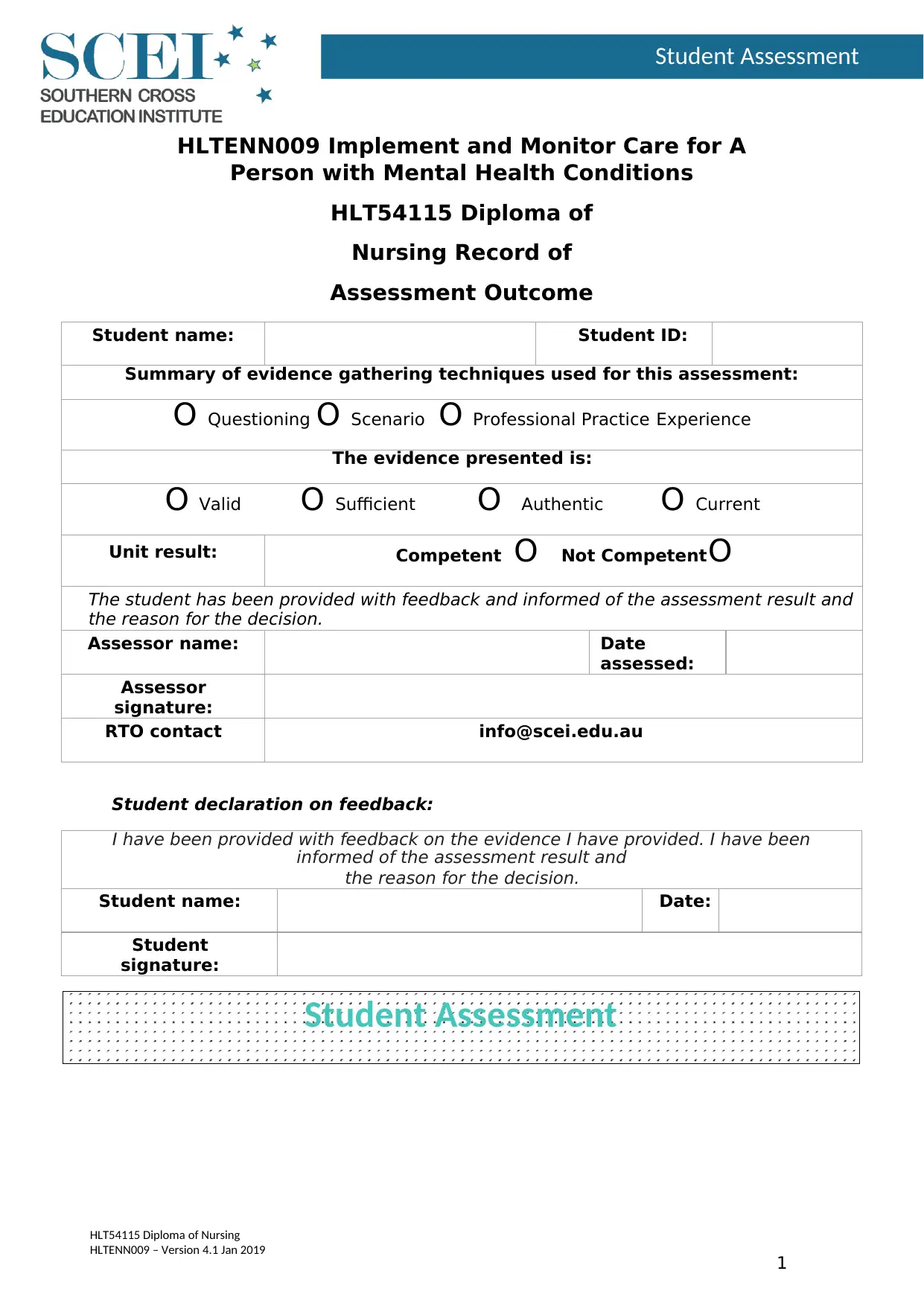
Student Assessment
HLT54115 Diploma of Nursing
HLTENN009 – Version 4.1 Jan 2019
1
Student Assessment
HLTENN009 Implement and Monitor Care for A
Person with Mental Health Conditions
HLT54115 Diploma of
Nursing Record of
Assessment Outcome
Student name: Student ID:
Summary of evidence gathering techniques used for this assessment:
O Questioning O Scenario O Professional Practice Experience
The evidence presented is:
O Valid O Sufficient O Authentic O Current
Unit result: Competent O Not CompetentO
The student has been provided with feedback and informed of the assessment result and
the reason for the decision.
Assessor name: Date
assessed:
Assessor
signature:
RTO contact info@scei.edu.au
Student declaration on feedback:
I have been provided with feedback on the evidence I have provided. I have been
informed of the assessment result and
the reason for the decision.
Student name: Date:
Student
signature:
HLT54115 Diploma of Nursing
HLTENN009 – Version 4.1 Jan 2019
1
Student Assessment
HLTENN009 Implement and Monitor Care for A
Person with Mental Health Conditions
HLT54115 Diploma of
Nursing Record of
Assessment Outcome
Student name: Student ID:
Summary of evidence gathering techniques used for this assessment:
O Questioning O Scenario O Professional Practice Experience
The evidence presented is:
O Valid O Sufficient O Authentic O Current
Unit result: Competent O Not CompetentO
The student has been provided with feedback and informed of the assessment result and
the reason for the decision.
Assessor name: Date
assessed:
Assessor
signature:
RTO contact info@scei.edu.au
Student declaration on feedback:
I have been provided with feedback on the evidence I have provided. I have been
informed of the assessment result and
the reason for the decision.
Student name: Date:
Student
signature:
Paraphrase This Document
Need a fresh take? Get an instant paraphrase of this document with our AI Paraphraser
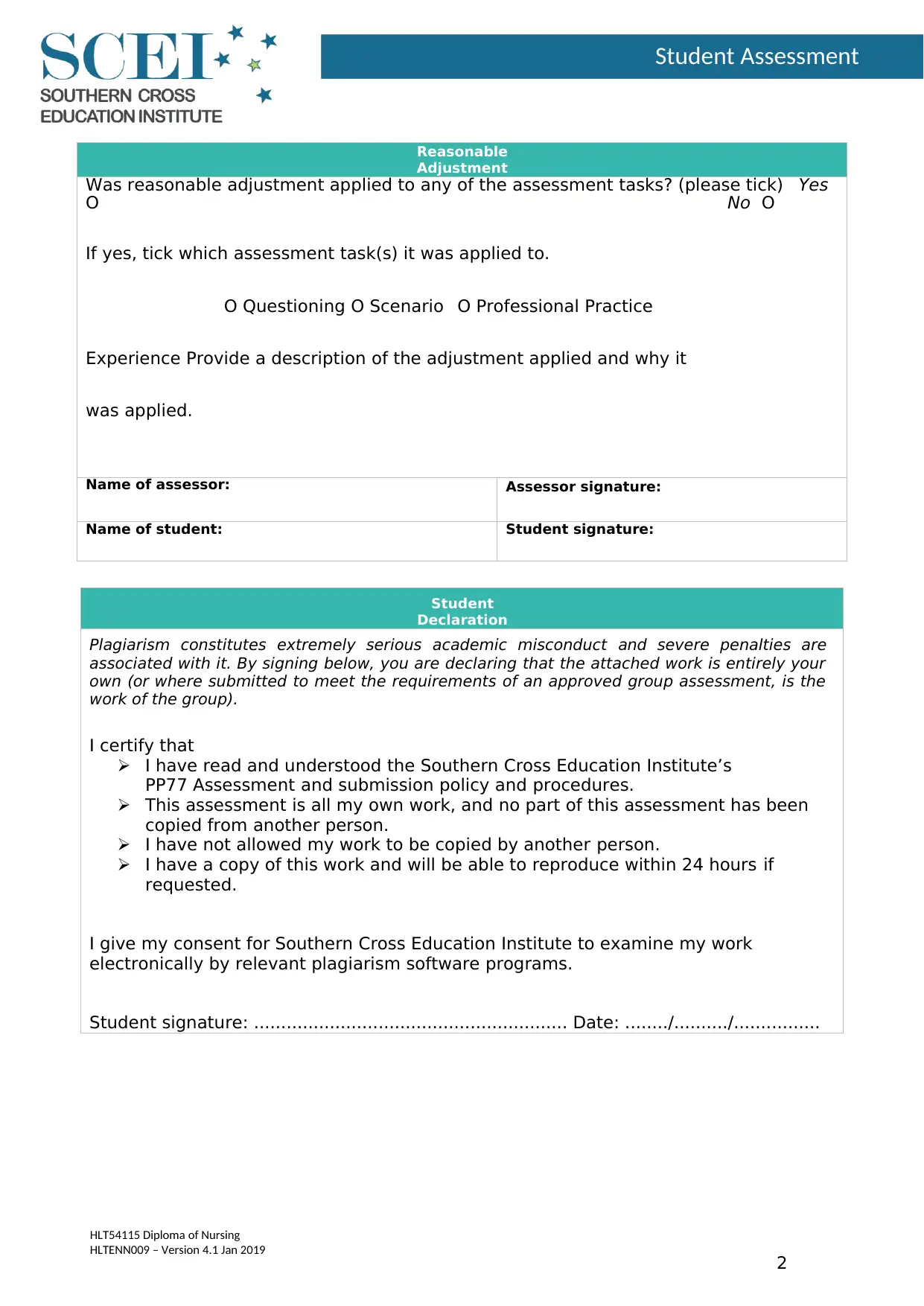
Student Assessment
HLT54115 Diploma of Nursing
HLTENN009 – Version 4.1 Jan 2019
2
Reasonable
Adjustment
Was reasonable adjustment applied to any of the assessment tasks? (please tick) Yes
O No O
If yes, tick which assessment task(s) it was applied to.
O Questioning O Scenario O Professional Practice
Experience Provide a description of the adjustment applied and why it
was applied.
Name of assessor: Assessor signature:
Name of student: Student signature:
Student
Declaration
Plagiarism constitutes extremely serious academic misconduct and severe penalties are
associated with it. By signing below, you are declaring that the attached work is entirely your
own (or where submitted to meet the requirements of an approved group assessment, is the
work of the group).
I certify that
I have read and understood the Southern Cross Education Institute’s
PP77 Assessment and submission policy and procedures.
This assessment is all my own work, and no part of this assessment has been
copied from another person.
I have not allowed my work to be copied by another person.
I have a copy of this work and will be able to reproduce within 24 hours if
requested.
I give my consent for Southern Cross Education Institute to examine my work
electronically by relevant plagiarism software programs.
Student signature: .......................................................... Date: ......../........../................
HLT54115 Diploma of Nursing
HLTENN009 – Version 4.1 Jan 2019
2
Reasonable
Adjustment
Was reasonable adjustment applied to any of the assessment tasks? (please tick) Yes
O No O
If yes, tick which assessment task(s) it was applied to.
O Questioning O Scenario O Professional Practice
Experience Provide a description of the adjustment applied and why it
was applied.
Name of assessor: Assessor signature:
Name of student: Student signature:
Student
Declaration
Plagiarism constitutes extremely serious academic misconduct and severe penalties are
associated with it. By signing below, you are declaring that the attached work is entirely your
own (or where submitted to meet the requirements of an approved group assessment, is the
work of the group).
I certify that
I have read and understood the Southern Cross Education Institute’s
PP77 Assessment and submission policy and procedures.
This assessment is all my own work, and no part of this assessment has been
copied from another person.
I have not allowed my work to be copied by another person.
I have a copy of this work and will be able to reproduce within 24 hours if
requested.
I give my consent for Southern Cross Education Institute to examine my work
electronically by relevant plagiarism software programs.
Student signature: .......................................................... Date: ......../........../................
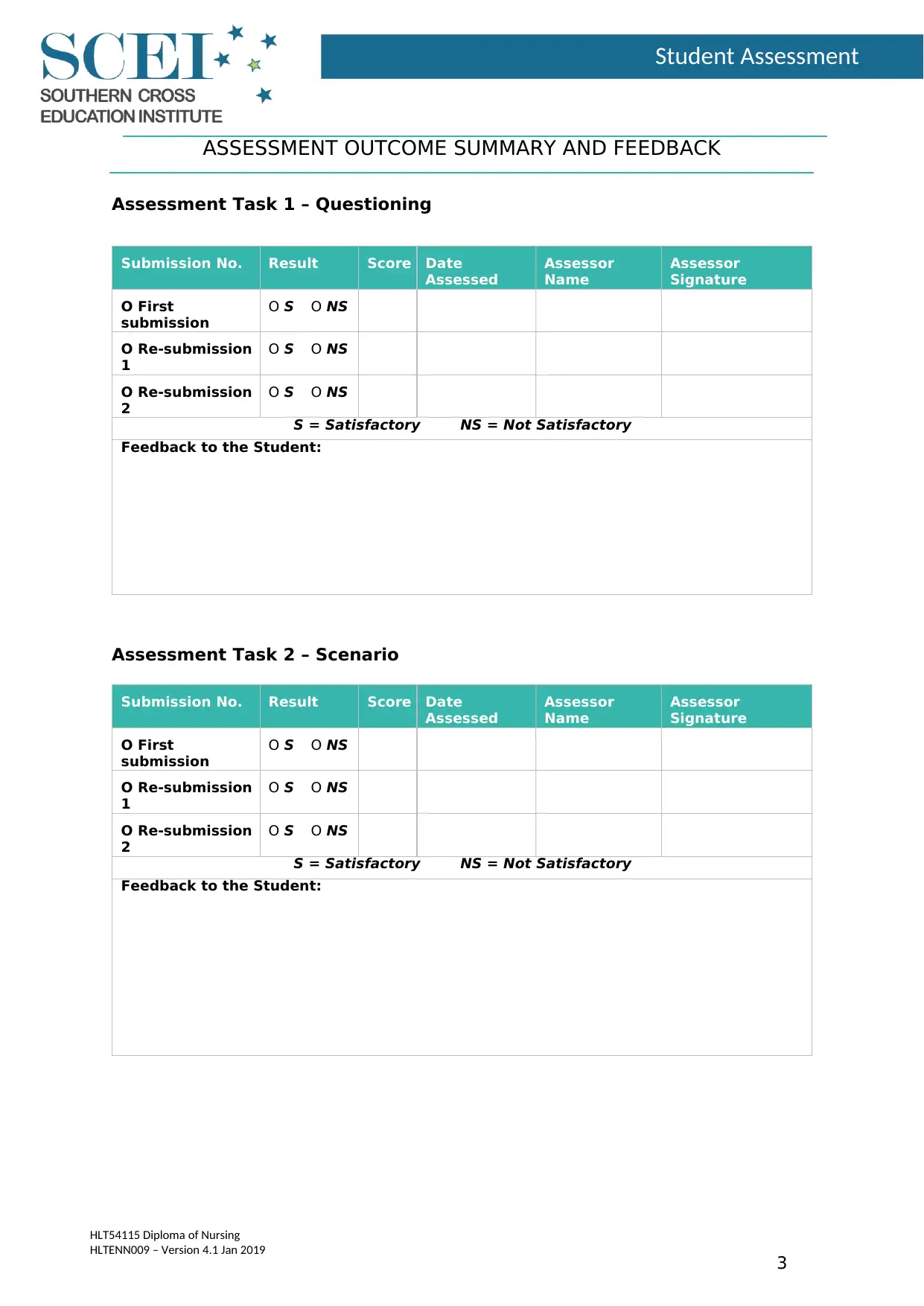
Student Assessment
HLT54115 Diploma of Nursing
HLTENN009 – Version 4.1 Jan 2019
3
ASSESSMENT OUTCOME SUMMARY AND FEEDBACK
Assessment Task 1 – Questioning
Submission No. Result Score Date
Assessed
Assessor
Name
Assessor
Signature
O First
submission
O S O NS
O Re-submission
1
O S O NS
O Re-submission
2
O S O NS
S = Satisfactory NS = Not Satisfactory
Feedback to the Student:
Assessment Task 2 – Scenario
Submission No. Result Score Date
Assessed
Assessor
Name
Assessor
Signature
O First
submission
O S O NS
O Re-submission
1
O S O NS
O Re-submission
2
O S O NS
S = Satisfactory NS = Not Satisfactory
Feedback to the Student:
HLT54115 Diploma of Nursing
HLTENN009 – Version 4.1 Jan 2019
3
ASSESSMENT OUTCOME SUMMARY AND FEEDBACK
Assessment Task 1 – Questioning
Submission No. Result Score Date
Assessed
Assessor
Name
Assessor
Signature
O First
submission
O S O NS
O Re-submission
1
O S O NS
O Re-submission
2
O S O NS
S = Satisfactory NS = Not Satisfactory
Feedback to the Student:
Assessment Task 2 – Scenario
Submission No. Result Score Date
Assessed
Assessor
Name
Assessor
Signature
O First
submission
O S O NS
O Re-submission
1
O S O NS
O Re-submission
2
O S O NS
S = Satisfactory NS = Not Satisfactory
Feedback to the Student:
⊘ This is a preview!⊘
Do you want full access?
Subscribe today to unlock all pages.

Trusted by 1+ million students worldwide
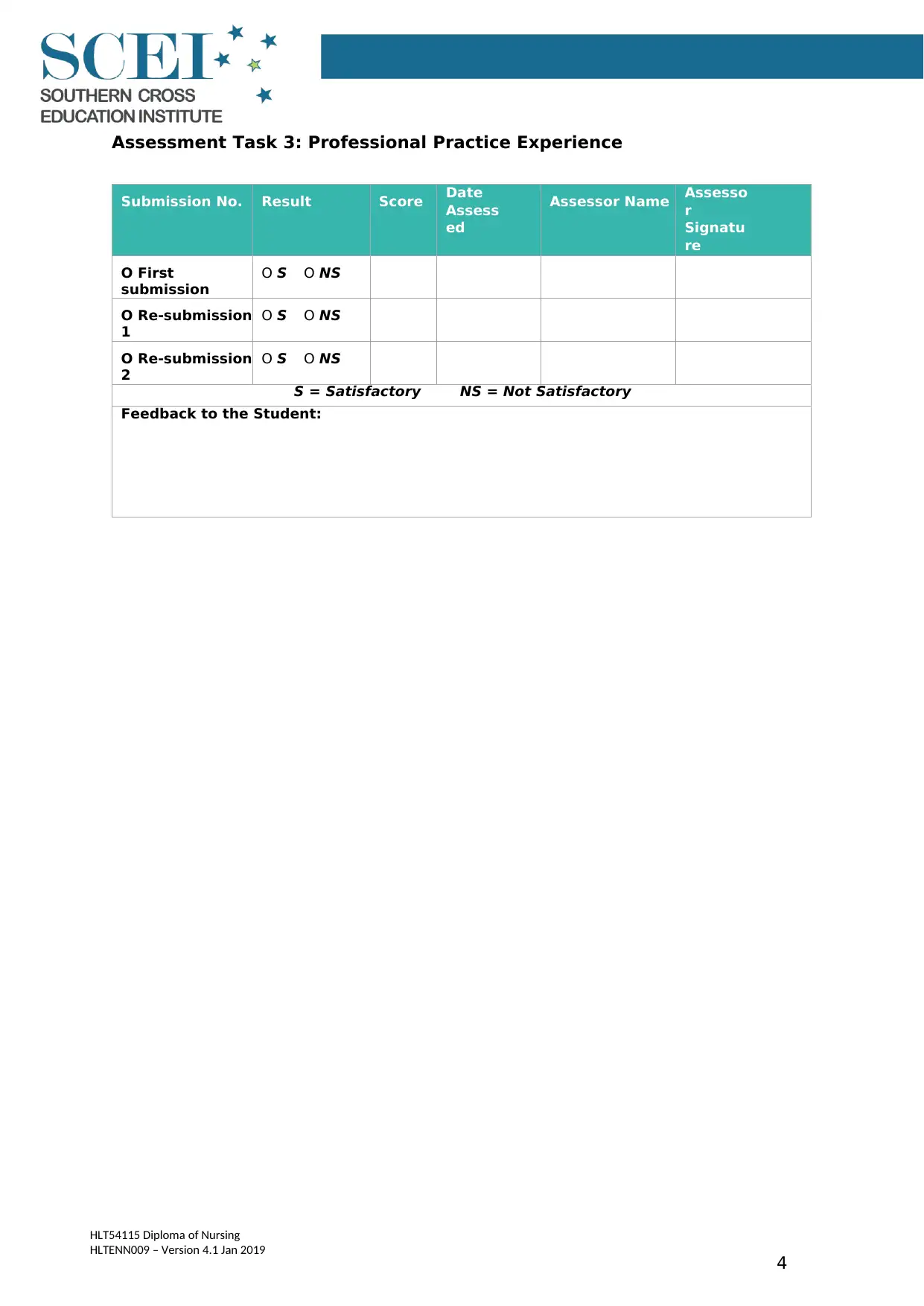
Student Assessment
4
HLT54115 Diploma of Nursing
HLTENN009 – Version 4.1 Jan 2019
Assessment Task 3: Professional Practice Experience
Submission No. Result Score Date
Assess
ed
Assessor Name Assesso
r
Signatu
re
O First
submission
O S O NS
O Re-submission
1
O S O NS
O Re-submission
2
O S O NS
S = Satisfactory NS = Not Satisfactory
Feedback to the Student:
4
HLT54115 Diploma of Nursing
HLTENN009 – Version 4.1 Jan 2019
Assessment Task 3: Professional Practice Experience
Submission No. Result Score Date
Assess
ed
Assessor Name Assesso
r
Signatu
re
O First
submission
O S O NS
O Re-submission
1
O S O NS
O Re-submission
2
O S O NS
S = Satisfactory NS = Not Satisfactory
Feedback to the Student:
Paraphrase This Document
Need a fresh take? Get an instant paraphrase of this document with our AI Paraphraser
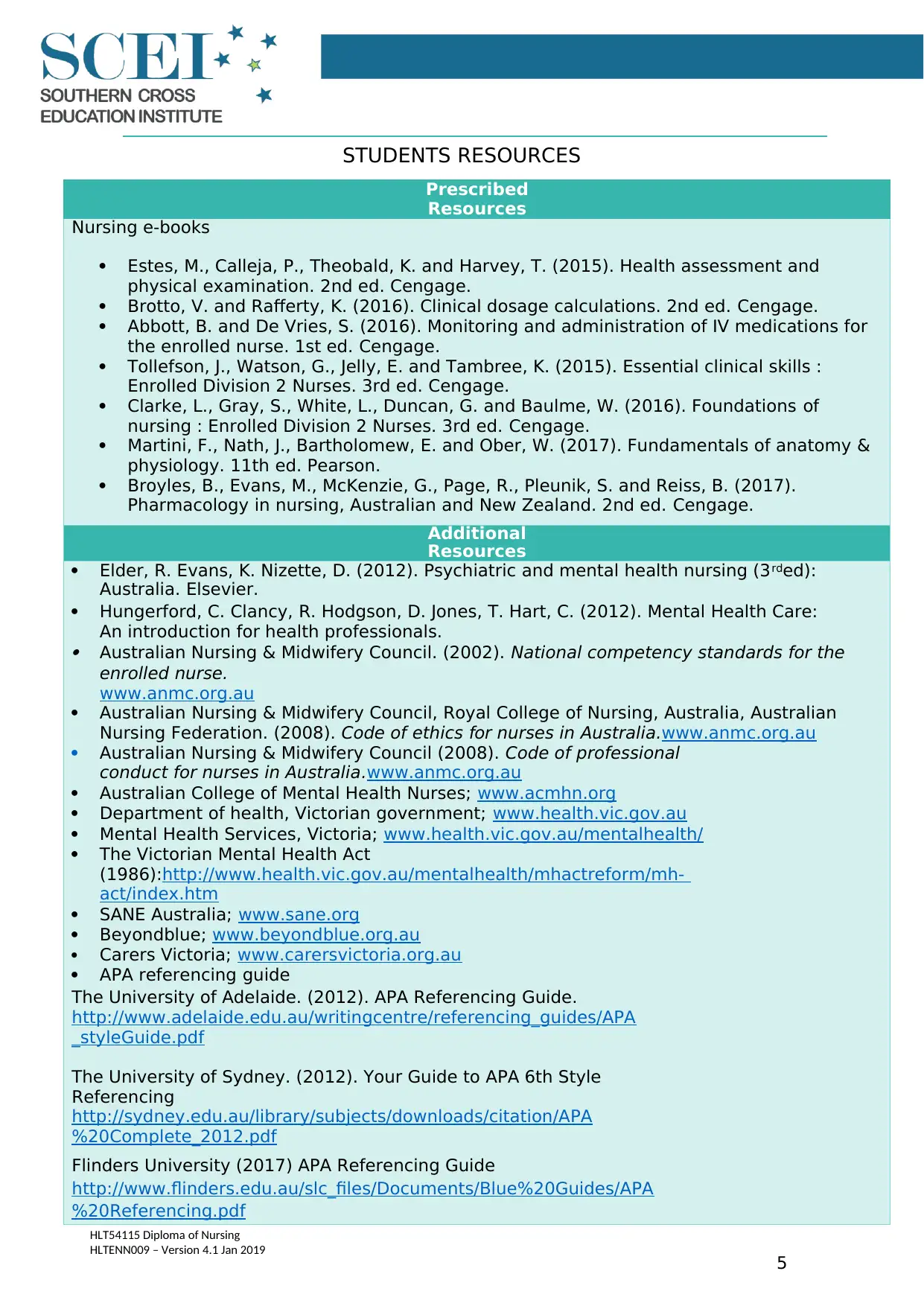
Student Assessment
5
HLT54115 Diploma of Nursing
HLTENN009 – Version 4.1 Jan 2019
STUDENTS RESOURCES
Prescribed
Resources
Nursing e-books
Estes, M., Calleja, P., Theobald, K. and Harvey, T. (2015). Health assessment and
physical examination. 2nd ed. Cengage.
Brotto, V. and Rafferty, K. (2016). Clinical dosage calculations. 2nd ed. Cengage.
Abbott, B. and De Vries, S. (2016). Monitoring and administration of IV medications for
the enrolled nurse. 1st ed. Cengage.
Tollefson, J., Watson, G., Jelly, E. and Tambree, K. (2015). Essential clinical skills :
Enrolled Division 2 Nurses. 3rd ed. Cengage.
Clarke, L., Gray, S., White, L., Duncan, G. and Baulme, W. (2016). Foundations of
nursing : Enrolled Division 2 Nurses. 3rd ed. Cengage.
Martini, F., Nath, J., Bartholomew, E. and Ober, W. (2017). Fundamentals of anatomy &
physiology. 11th ed. Pearson.
Broyles, B., Evans, M., McKenzie, G., Page, R., Pleunik, S. and Reiss, B. (2017).
Pharmacology in nursing, Australian and New Zealand. 2nd ed. Cengage.
Additional
Resources
Elder, R. Evans, K. Nizette, D. (2012). Psychiatric and mental health nursing (3rded):
Australia. Elsevier.
Hungerford, C. Clancy, R. Hodgson, D. Jones, T. Hart, C. (2012). Mental Health Care:
An introduction for health professionals. Australian Nursing & Midwifery Council. (2002). National competency standards for the
enrolled nurse.
www.anmc.org.au
Australian Nursing & Midwifery Council, Royal College of Nursing, Australia, Australian
Nursing Federation. (2008). Code of ethics for nurses in Australia.www.anmc.org.au
Australian Nursing & Midwifery Council (2008). Code of professional
conduct for nurses in Australia.www.anmc.org.au
Australian College of Mental Health Nurses; www.acmhn.org
Department of health, Victorian government; www.health.vic.gov.au
Mental Health Services, Victoria; www.health.vic.gov.au/mentalhealth/
The Victorian Mental Health Act
(1986):http://www.health.vic.gov.au/mentalhealth/mhactreform/mh-
act/index.htm
SANE Australia; www.sane.org
Beyondblue; www.beyondblue.org.au
Carers Victoria; www.carersvictoria.org.au
APA referencing guide
The University of Adelaide. (2012). APA Referencing Guide.
http://www.adelaide.edu.au/writingcentre/referencing_guides/APA
_styleGuide.pdf
The University of Sydney. (2012). Your Guide to APA 6th Style
Referencing
http://sydney.edu.au/library/subjects/downloads/citation/APA
%20Complete_2012.pdf
Flinders University (2017) APA Referencing Guide
http://www.flinders.edu.au/slc_files/Documents/Blue%20Guides/APA
%20Referencing.pdf
5
HLT54115 Diploma of Nursing
HLTENN009 – Version 4.1 Jan 2019
STUDENTS RESOURCES
Prescribed
Resources
Nursing e-books
Estes, M., Calleja, P., Theobald, K. and Harvey, T. (2015). Health assessment and
physical examination. 2nd ed. Cengage.
Brotto, V. and Rafferty, K. (2016). Clinical dosage calculations. 2nd ed. Cengage.
Abbott, B. and De Vries, S. (2016). Monitoring and administration of IV medications for
the enrolled nurse. 1st ed. Cengage.
Tollefson, J., Watson, G., Jelly, E. and Tambree, K. (2015). Essential clinical skills :
Enrolled Division 2 Nurses. 3rd ed. Cengage.
Clarke, L., Gray, S., White, L., Duncan, G. and Baulme, W. (2016). Foundations of
nursing : Enrolled Division 2 Nurses. 3rd ed. Cengage.
Martini, F., Nath, J., Bartholomew, E. and Ober, W. (2017). Fundamentals of anatomy &
physiology. 11th ed. Pearson.
Broyles, B., Evans, M., McKenzie, G., Page, R., Pleunik, S. and Reiss, B. (2017).
Pharmacology in nursing, Australian and New Zealand. 2nd ed. Cengage.
Additional
Resources
Elder, R. Evans, K. Nizette, D. (2012). Psychiatric and mental health nursing (3rded):
Australia. Elsevier.
Hungerford, C. Clancy, R. Hodgson, D. Jones, T. Hart, C. (2012). Mental Health Care:
An introduction for health professionals. Australian Nursing & Midwifery Council. (2002). National competency standards for the
enrolled nurse.
www.anmc.org.au
Australian Nursing & Midwifery Council, Royal College of Nursing, Australia, Australian
Nursing Federation. (2008). Code of ethics for nurses in Australia.www.anmc.org.au
Australian Nursing & Midwifery Council (2008). Code of professional
conduct for nurses in Australia.www.anmc.org.au
Australian College of Mental Health Nurses; www.acmhn.org
Department of health, Victorian government; www.health.vic.gov.au
Mental Health Services, Victoria; www.health.vic.gov.au/mentalhealth/
The Victorian Mental Health Act
(1986):http://www.health.vic.gov.au/mentalhealth/mhactreform/mh-
act/index.htm
SANE Australia; www.sane.org
Beyondblue; www.beyondblue.org.au
Carers Victoria; www.carersvictoria.org.au
APA referencing guide
The University of Adelaide. (2012). APA Referencing Guide.
http://www.adelaide.edu.au/writingcentre/referencing_guides/APA
_styleGuide.pdf
The University of Sydney. (2012). Your Guide to APA 6th Style
Referencing
http://sydney.edu.au/library/subjects/downloads/citation/APA
%20Complete_2012.pdf
Flinders University (2017) APA Referencing Guide
http://www.flinders.edu.au/slc_files/Documents/Blue%20Guides/APA
%20Referencing.pdf
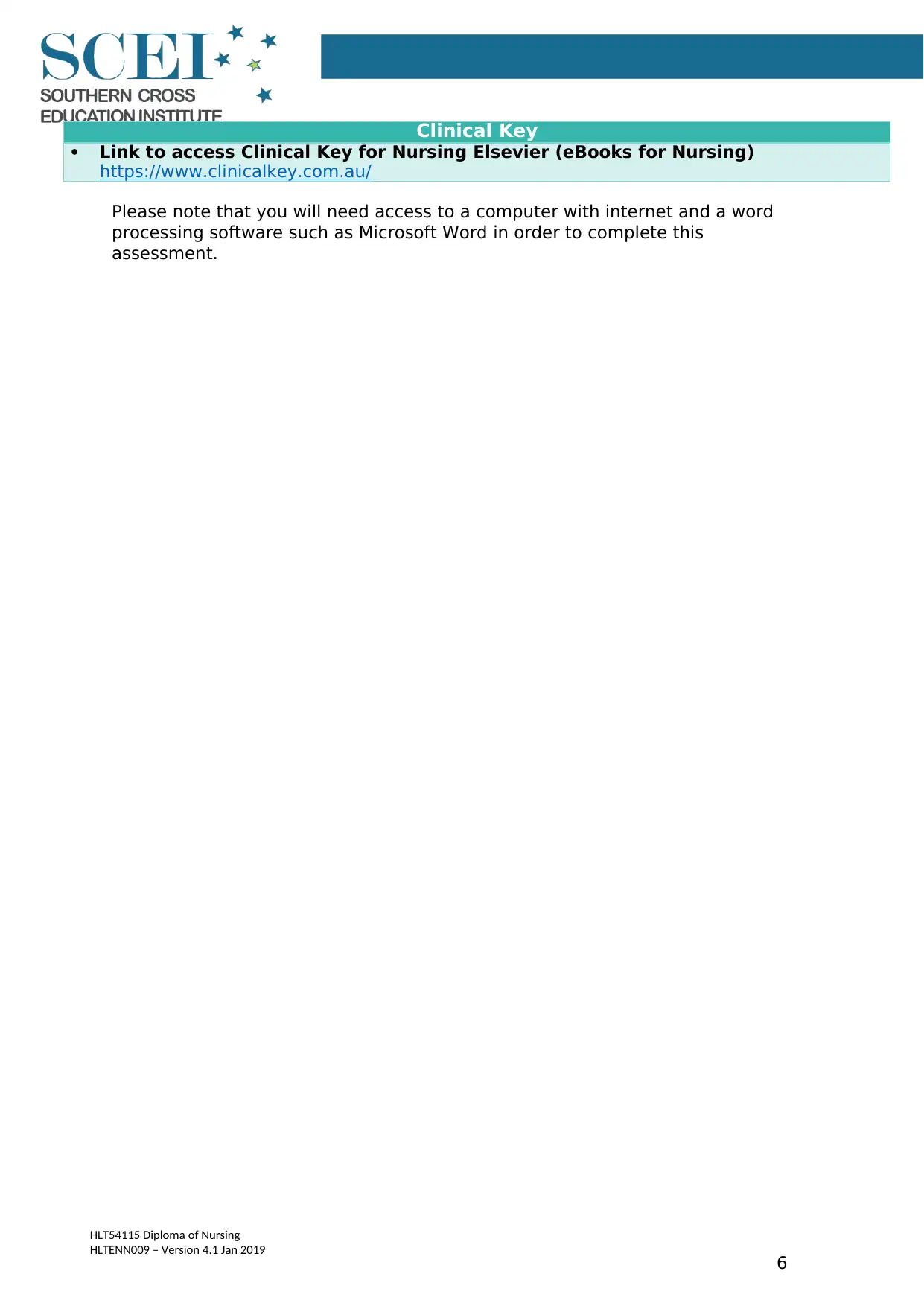
Student Assessment
6
HLT54115 Diploma of Nursing
HLTENN009 – Version 4.1 Jan 2019
Clinical Key
Link to access Clinical Key for Nursing Elsevier (eBooks for Nursing)
https://www.clinicalkey.com.au/
Please note that you will need access to a computer with internet and a word
processing software such as Microsoft Word in order to complete this
assessment.
6
HLT54115 Diploma of Nursing
HLTENN009 – Version 4.1 Jan 2019
Clinical Key
Link to access Clinical Key for Nursing Elsevier (eBooks for Nursing)
https://www.clinicalkey.com.au/
Please note that you will need access to a computer with internet and a word
processing software such as Microsoft Word in order to complete this
assessment.
⊘ This is a preview!⊘
Do you want full access?
Subscribe today to unlock all pages.

Trusted by 1+ million students worldwide
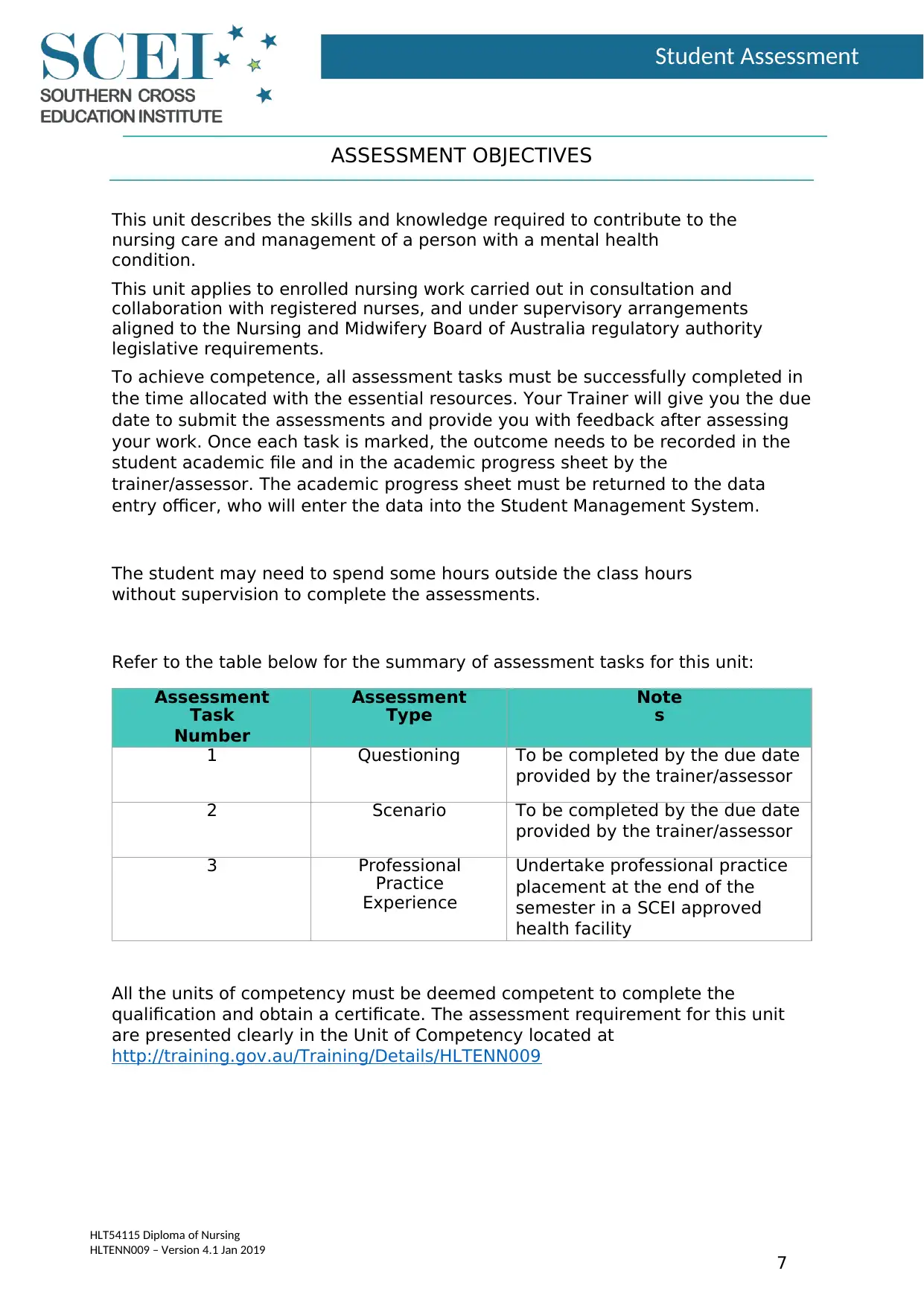
Student Assessment
HLT54115 Diploma of Nursing
HLTENN009 – Version 4.1 Jan 2019
7
ASSESSMENT OBJECTIVES
This unit describes the skills and knowledge required to contribute to the
nursing care and management of a person with a mental health
condition.
This unit applies to enrolled nursing work carried out in consultation and
collaboration with registered nurses, and under supervisory arrangements
aligned to the Nursing and Midwifery Board of Australia regulatory authority
legislative requirements.
To achieve competence, all assessment tasks must be successfully completed in
the time allocated with the essential resources. Your Trainer will give you the due
date to submit the assessments and provide you with feedback after assessing
your work. Once each task is marked, the outcome needs to be recorded in the
student academic file and in the academic progress sheet by the
trainer/assessor. The academic progress sheet must be returned to the data
entry officer, who will enter the data into the Student Management System.
The student may need to spend some hours outside the class hours
without supervision to complete the assessments.
Refer to the table below for the summary of assessment tasks for this unit:
Assessment
Task
Number
Assessment
Type
Note
s
1 Questioning To be completed by the due date
provided by the trainer/assessor
2 Scenario To be completed by the due date
provided by the trainer/assessor
3 Professional
Practice
Experience
Undertake professional practice
placement at the end of the
semester in a SCEI approved
health facility
All the units of competency must be deemed competent to complete the
qualification and obtain a certificate. The assessment requirement for this unit
are presented clearly in the Unit of Competency located at
http://training.gov.au/Training/Details/HLTENN009
HLT54115 Diploma of Nursing
HLTENN009 – Version 4.1 Jan 2019
7
ASSESSMENT OBJECTIVES
This unit describes the skills and knowledge required to contribute to the
nursing care and management of a person with a mental health
condition.
This unit applies to enrolled nursing work carried out in consultation and
collaboration with registered nurses, and under supervisory arrangements
aligned to the Nursing and Midwifery Board of Australia regulatory authority
legislative requirements.
To achieve competence, all assessment tasks must be successfully completed in
the time allocated with the essential resources. Your Trainer will give you the due
date to submit the assessments and provide you with feedback after assessing
your work. Once each task is marked, the outcome needs to be recorded in the
student academic file and in the academic progress sheet by the
trainer/assessor. The academic progress sheet must be returned to the data
entry officer, who will enter the data into the Student Management System.
The student may need to spend some hours outside the class hours
without supervision to complete the assessments.
Refer to the table below for the summary of assessment tasks for this unit:
Assessment
Task
Number
Assessment
Type
Note
s
1 Questioning To be completed by the due date
provided by the trainer/assessor
2 Scenario To be completed by the due date
provided by the trainer/assessor
3 Professional
Practice
Experience
Undertake professional practice
placement at the end of the
semester in a SCEI approved
health facility
All the units of competency must be deemed competent to complete the
qualification and obtain a certificate. The assessment requirement for this unit
are presented clearly in the Unit of Competency located at
http://training.gov.au/Training/Details/HLTENN009
Paraphrase This Document
Need a fresh take? Get an instant paraphrase of this document with our AI Paraphraser
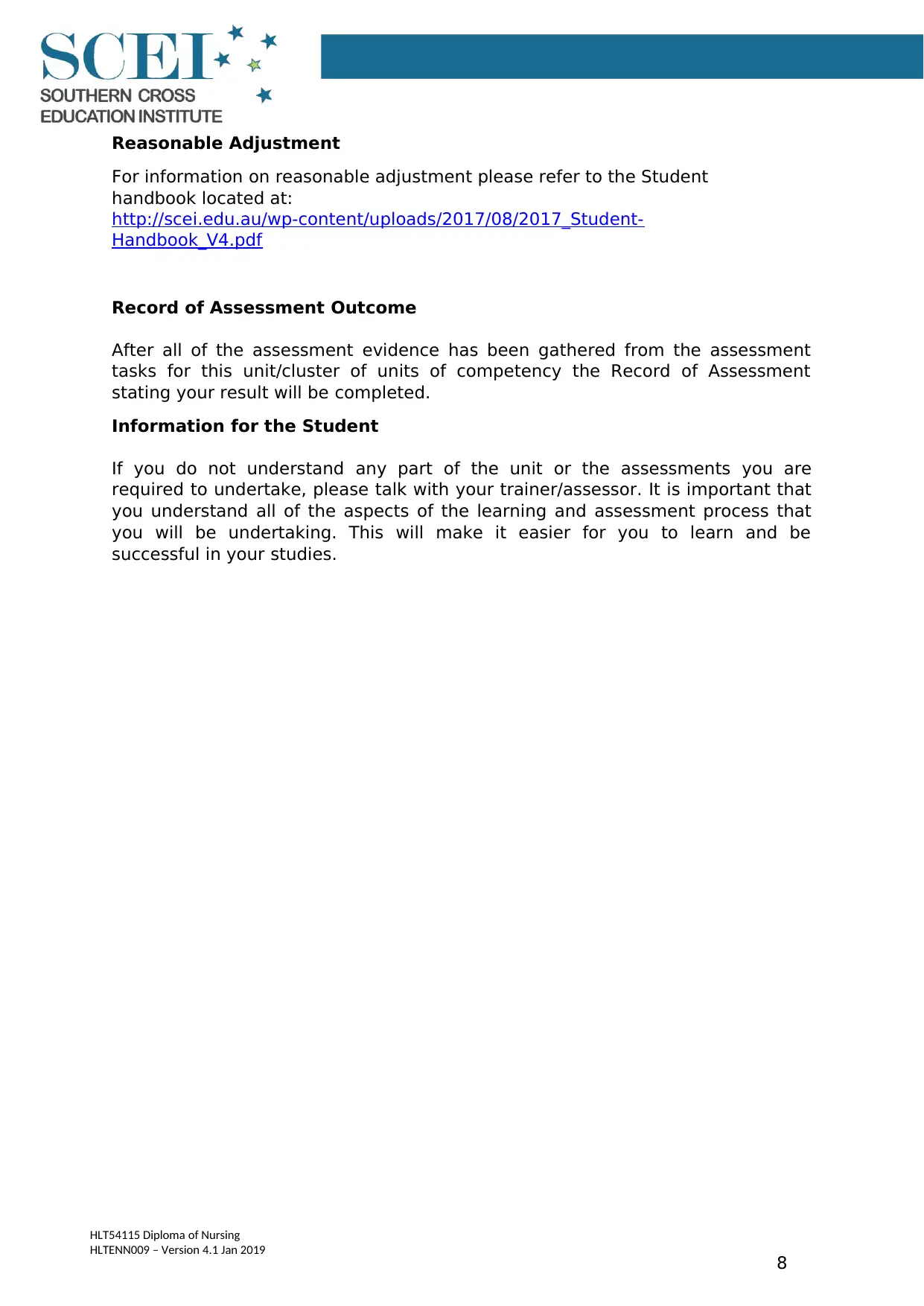
Student Assessment
8
HLT54115 Diploma of Nursing
HLTENN009 – Version 4.1 Jan 2019
Reasonable Adjustment
For information on reasonable adjustment please refer to the Student
handbook located at:
http://scei.edu.au/wp-content/uploads/2017/08/2017_Student-
Handbook_V4.pdf
Record of Assessment Outcome
After all of the assessment evidence has been gathered from the assessment
tasks for this unit/cluster of units of competency the Record of Assessment
stating your result will be completed.
Information for the Student
If you do not understand any part of the unit or the assessments you are
required to undertake, please talk with your trainer/assessor. It is important that
you understand all of the aspects of the learning and assessment process that
you will be undertaking. This will make it easier for you to learn and be
successful in your studies.
8
HLT54115 Diploma of Nursing
HLTENN009 – Version 4.1 Jan 2019
Reasonable Adjustment
For information on reasonable adjustment please refer to the Student
handbook located at:
http://scei.edu.au/wp-content/uploads/2017/08/2017_Student-
Handbook_V4.pdf
Record of Assessment Outcome
After all of the assessment evidence has been gathered from the assessment
tasks for this unit/cluster of units of competency the Record of Assessment
stating your result will be completed.
Information for the Student
If you do not understand any part of the unit or the assessments you are
required to undertake, please talk with your trainer/assessor. It is important that
you understand all of the aspects of the learning and assessment process that
you will be undertaking. This will make it easier for you to learn and be
successful in your studies.
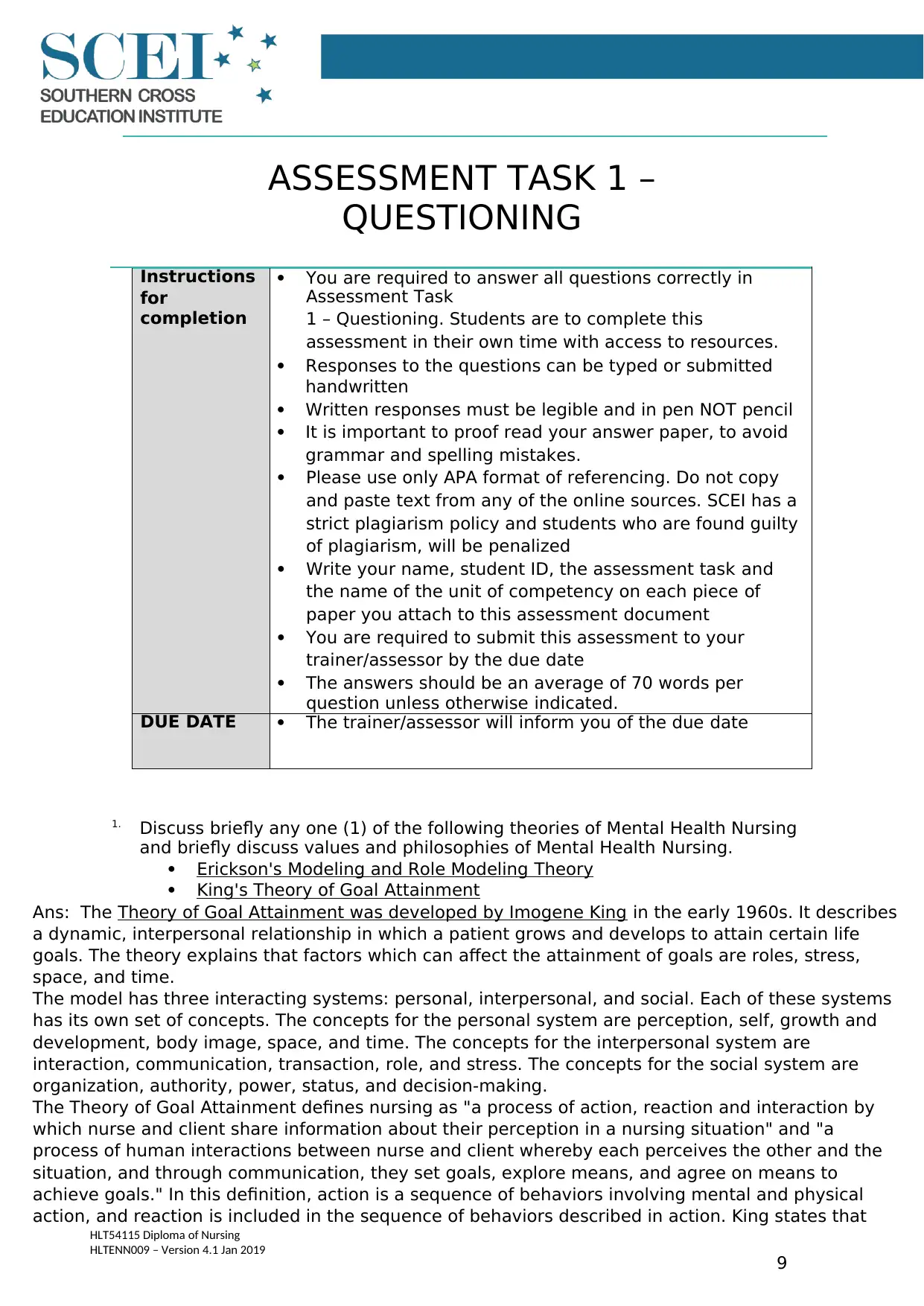
Student Assessment
9
HLT54115 Diploma of Nursing
HLTENN009 – Version 4.1 Jan 2019
ASSESSMENT TASK 1 –
QUESTIONING
Instructions
for
completion
You are required to answer all questions correctly in
Assessment Task
1 – Questioning. Students are to complete this
assessment in their own time with access to resources.
Responses to the questions can be typed or submitted
handwritten
Written responses must be legible and in pen NOT pencil
It is important to proof read your answer paper, to avoid
grammar and spelling mistakes.
Please use only APA format of referencing. Do not copy
and paste text from any of the online sources. SCEI has a
strict plagiarism policy and students who are found guilty
of plagiarism, will be penalized
Write your name, student ID, the assessment task and
the name of the unit of competency on each piece of
paper you attach to this assessment document
You are required to submit this assessment to your
trainer/assessor by the due date
The answers should be an average of 70 words per
question unless otherwise indicated.
DUE DATE The trainer/assessor will inform you of the due date
1. Discuss briefly any one (1) of the following theories of Mental Health Nursing
and briefly discuss values and philosophies of Mental Health Nursing.
Erickson's Modeling and Role Modeling Theory
King's Theory of Goal Attainment
Ans: The Theory of Goal Attainment was developed by Imogene King in the early 1960s. It describes
a dynamic, interpersonal relationship in which a patient grows and develops to attain certain life
goals. The theory explains that factors which can affect the attainment of goals are roles, stress,
space, and time.
The model has three interacting systems: personal, interpersonal, and social. Each of these systems
has its own set of concepts. The concepts for the personal system are perception, self, growth and
development, body image, space, and time. The concepts for the interpersonal system are
interaction, communication, transaction, role, and stress. The concepts for the social system are
organization, authority, power, status, and decision-making.
The Theory of Goal Attainment defines nursing as "a process of action, reaction and interaction by
which nurse and client share information about their perception in a nursing situation" and "a
process of human interactions between nurse and client whereby each perceives the other and the
situation, and through communication, they set goals, explore means, and agree on means to
achieve goals." In this definition, action is a sequence of behaviors involving mental and physical
action, and reaction is included in the sequence of behaviors described in action. King states that
9
HLT54115 Diploma of Nursing
HLTENN009 – Version 4.1 Jan 2019
ASSESSMENT TASK 1 –
QUESTIONING
Instructions
for
completion
You are required to answer all questions correctly in
Assessment Task
1 – Questioning. Students are to complete this
assessment in their own time with access to resources.
Responses to the questions can be typed or submitted
handwritten
Written responses must be legible and in pen NOT pencil
It is important to proof read your answer paper, to avoid
grammar and spelling mistakes.
Please use only APA format of referencing. Do not copy
and paste text from any of the online sources. SCEI has a
strict plagiarism policy and students who are found guilty
of plagiarism, will be penalized
Write your name, student ID, the assessment task and
the name of the unit of competency on each piece of
paper you attach to this assessment document
You are required to submit this assessment to your
trainer/assessor by the due date
The answers should be an average of 70 words per
question unless otherwise indicated.
DUE DATE The trainer/assessor will inform you of the due date
1. Discuss briefly any one (1) of the following theories of Mental Health Nursing
and briefly discuss values and philosophies of Mental Health Nursing.
Erickson's Modeling and Role Modeling Theory
King's Theory of Goal Attainment
Ans: The Theory of Goal Attainment was developed by Imogene King in the early 1960s. It describes
a dynamic, interpersonal relationship in which a patient grows and develops to attain certain life
goals. The theory explains that factors which can affect the attainment of goals are roles, stress,
space, and time.
The model has three interacting systems: personal, interpersonal, and social. Each of these systems
has its own set of concepts. The concepts for the personal system are perception, self, growth and
development, body image, space, and time. The concepts for the interpersonal system are
interaction, communication, transaction, role, and stress. The concepts for the social system are
organization, authority, power, status, and decision-making.
The Theory of Goal Attainment defines nursing as "a process of action, reaction and interaction by
which nurse and client share information about their perception in a nursing situation" and "a
process of human interactions between nurse and client whereby each perceives the other and the
situation, and through communication, they set goals, explore means, and agree on means to
achieve goals." In this definition, action is a sequence of behaviors involving mental and physical
action, and reaction is included in the sequence of behaviors described in action. King states that
⊘ This is a preview!⊘
Do you want full access?
Subscribe today to unlock all pages.

Trusted by 1+ million students worldwide
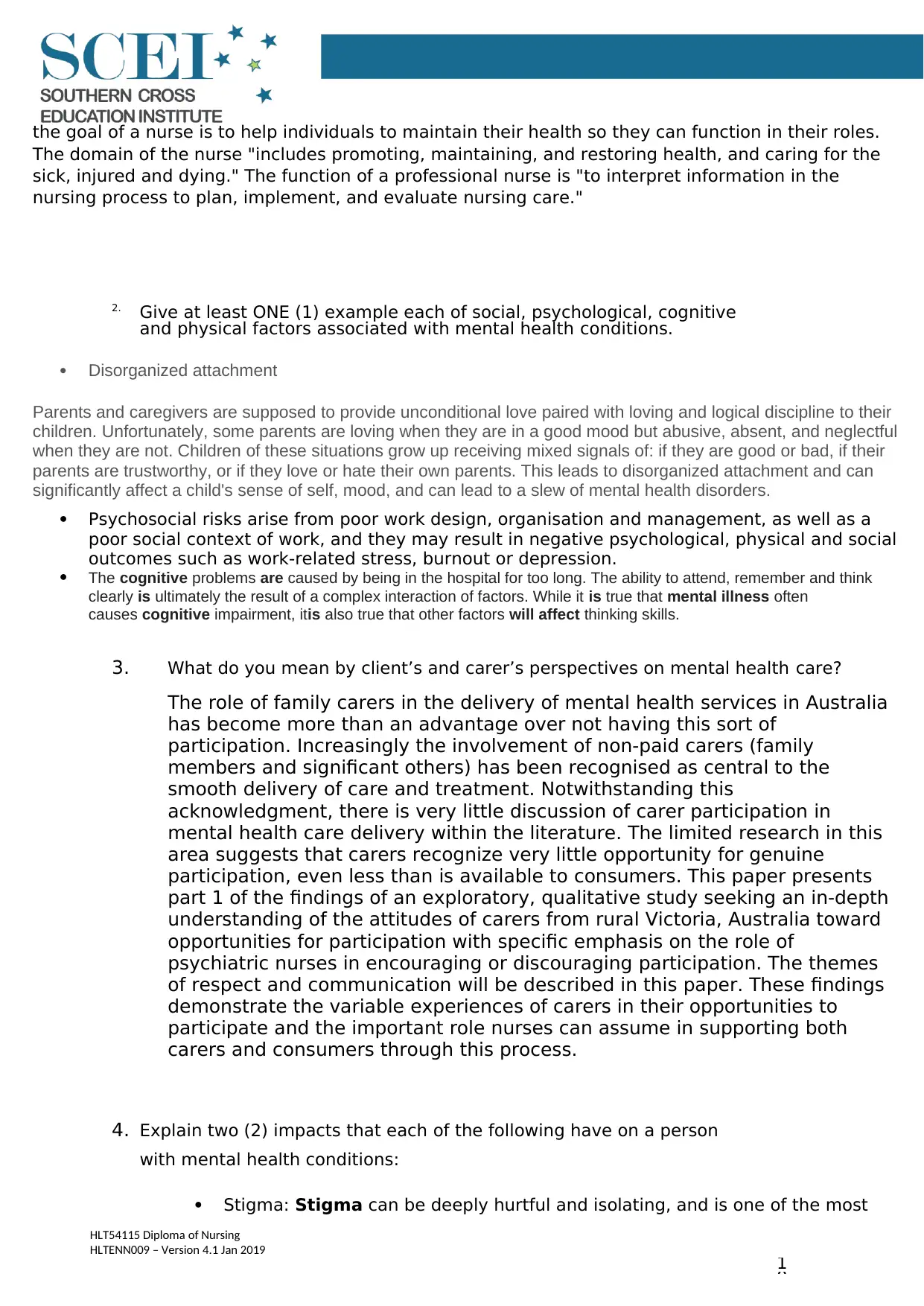
Student Assessment
1
0
HLT54115 Diploma of Nursing
HLTENN009 – Version 4.1 Jan 2019
the goal of a nurse is to help individuals to maintain their health so they can function in their roles.
The domain of the nurse "includes promoting, maintaining, and restoring health, and caring for the
sick, injured and dying." The function of a professional nurse is "to interpret information in the
nursing process to plan, implement, and evaluate nursing care."
2. Give at least ONE (1) example each of social, psychological, cognitive
and physical factors associated with mental health conditions.
Disorganized attachment
Parents and caregivers are supposed to provide unconditional love paired with loving and logical discipline to their
children. Unfortunately, some parents are loving when they are in a good mood but abusive, absent, and neglectful
when they are not. Children of these situations grow up receiving mixed signals of: if they are good or bad, if their
parents are trustworthy, or if they love or hate their own parents. This leads to disorganized attachment and can
significantly affect a child's sense of self, mood, and can lead to a slew of mental health disorders.
Psychosocial risks arise from poor work design, organisation and management, as well as a
poor social context of work, and they may result in negative psychological, physical and social
outcomes such as work-related stress, burnout or depression.
The cognitive problems are caused by being in the hospital for too long. The ability to attend, remember and think
clearly is ultimately the result of a complex interaction of factors. While it is true that mental illness often
causes cognitive impairment, itis also true that other factors will affect thinking skills.
3. What do you mean by client’s and carer’s perspectives on mental health care?
The role of family carers in the delivery of mental health services in Australia
has become more than an advantage over not having this sort of
participation. Increasingly the involvement of non-paid carers (family
members and significant others) has been recognised as central to the
smooth delivery of care and treatment. Notwithstanding this
acknowledgment, there is very little discussion of carer participation in
mental health care delivery within the literature. The limited research in this
area suggests that carers recognize very little opportunity for genuine
participation, even less than is available to consumers. This paper presents
part 1 of the findings of an exploratory, qualitative study seeking an in-depth
understanding of the attitudes of carers from rural Victoria, Australia toward
opportunities for participation with specific emphasis on the role of
psychiatric nurses in encouraging or discouraging participation. The themes
of respect and communication will be described in this paper. These findings
demonstrate the variable experiences of carers in their opportunities to
participate and the important role nurses can assume in supporting both
carers and consumers through this process.
4. Explain two (2) impacts that each of the following have on a person
with mental health conditions:
Stigma: Stigma can be deeply hurtful and isolating, and is one of the most
1
0
HLT54115 Diploma of Nursing
HLTENN009 – Version 4.1 Jan 2019
the goal of a nurse is to help individuals to maintain their health so they can function in their roles.
The domain of the nurse "includes promoting, maintaining, and restoring health, and caring for the
sick, injured and dying." The function of a professional nurse is "to interpret information in the
nursing process to plan, implement, and evaluate nursing care."
2. Give at least ONE (1) example each of social, psychological, cognitive
and physical factors associated with mental health conditions.
Disorganized attachment
Parents and caregivers are supposed to provide unconditional love paired with loving and logical discipline to their
children. Unfortunately, some parents are loving when they are in a good mood but abusive, absent, and neglectful
when they are not. Children of these situations grow up receiving mixed signals of: if they are good or bad, if their
parents are trustworthy, or if they love or hate their own parents. This leads to disorganized attachment and can
significantly affect a child's sense of self, mood, and can lead to a slew of mental health disorders.
Psychosocial risks arise from poor work design, organisation and management, as well as a
poor social context of work, and they may result in negative psychological, physical and social
outcomes such as work-related stress, burnout or depression.
The cognitive problems are caused by being in the hospital for too long. The ability to attend, remember and think
clearly is ultimately the result of a complex interaction of factors. While it is true that mental illness often
causes cognitive impairment, itis also true that other factors will affect thinking skills.
3. What do you mean by client’s and carer’s perspectives on mental health care?
The role of family carers in the delivery of mental health services in Australia
has become more than an advantage over not having this sort of
participation. Increasingly the involvement of non-paid carers (family
members and significant others) has been recognised as central to the
smooth delivery of care and treatment. Notwithstanding this
acknowledgment, there is very little discussion of carer participation in
mental health care delivery within the literature. The limited research in this
area suggests that carers recognize very little opportunity for genuine
participation, even less than is available to consumers. This paper presents
part 1 of the findings of an exploratory, qualitative study seeking an in-depth
understanding of the attitudes of carers from rural Victoria, Australia toward
opportunities for participation with specific emphasis on the role of
psychiatric nurses in encouraging or discouraging participation. The themes
of respect and communication will be described in this paper. These findings
demonstrate the variable experiences of carers in their opportunities to
participate and the important role nurses can assume in supporting both
carers and consumers through this process.
4. Explain two (2) impacts that each of the following have on a person
with mental health conditions:
Stigma: Stigma can be deeply hurtful and isolating, and is one of the most
Paraphrase This Document
Need a fresh take? Get an instant paraphrase of this document with our AI Paraphraser
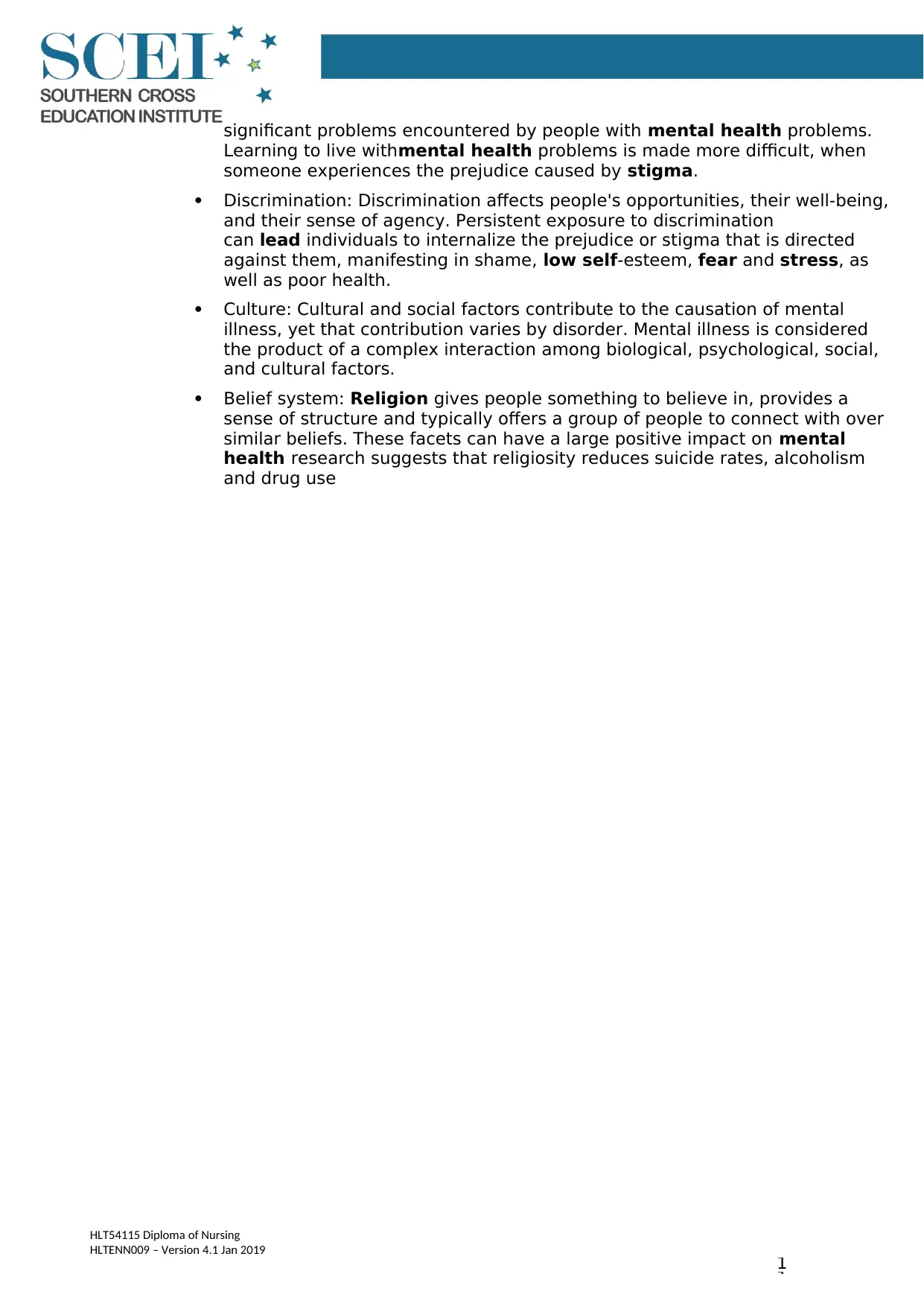
Student Assessment
1
1
HLT54115 Diploma of Nursing
HLTENN009 – Version 4.1 Jan 2019
significant problems encountered by people with mental health problems.
Learning to live withmental health problems is made more difficult, when
someone experiences the prejudice caused by stigma.
Discrimination: Discrimination affects people's opportunities, their well-being,
and their sense of agency. Persistent exposure to discrimination
can lead individuals to internalize the prejudice or stigma that is directed
against them, manifesting in shame, low self-esteem, fear and stress, as
well as poor health.
Culture: Cultural and social factors contribute to the causation of mental
illness, yet that contribution varies by disorder. Mental illness is considered
the product of a complex interaction among biological, psychological, social,
and cultural factors.
Belief system: Religion gives people something to believe in, provides a
sense of structure and typically offers a group of people to connect with over
similar beliefs. These facets can have a large positive impact on mental
health research suggests that religiosity reduces suicide rates, alcoholism
and drug use
1
1
HLT54115 Diploma of Nursing
HLTENN009 – Version 4.1 Jan 2019
significant problems encountered by people with mental health problems.
Learning to live withmental health problems is made more difficult, when
someone experiences the prejudice caused by stigma.
Discrimination: Discrimination affects people's opportunities, their well-being,
and their sense of agency. Persistent exposure to discrimination
can lead individuals to internalize the prejudice or stigma that is directed
against them, manifesting in shame, low self-esteem, fear and stress, as
well as poor health.
Culture: Cultural and social factors contribute to the causation of mental
illness, yet that contribution varies by disorder. Mental illness is considered
the product of a complex interaction among biological, psychological, social,
and cultural factors.
Belief system: Religion gives people something to believe in, provides a
sense of structure and typically offers a group of people to connect with over
similar beliefs. These facets can have a large positive impact on mental
health research suggests that religiosity reduces suicide rates, alcoholism
and drug use
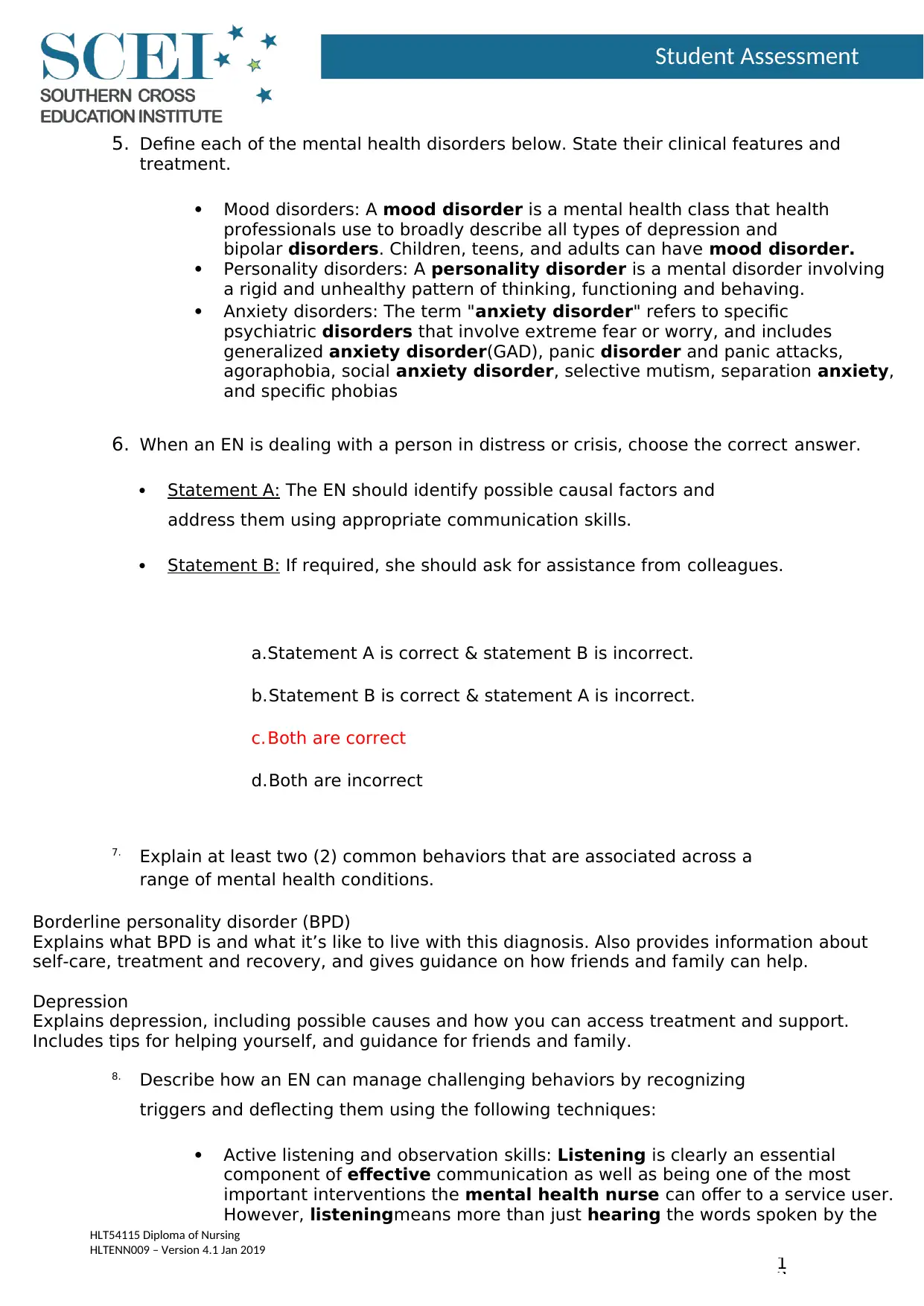
Student Assessment
HLT54115 Diploma of Nursing
HLTENN009 – Version 4.1 Jan 2019
1
2
5. Define each of the mental health disorders below. State their clinical features and
treatment.
Mood disorders: A mood disorder is a mental health class that health
professionals use to broadly describe all types of depression and
bipolar disorders. Children, teens, and adults can have mood disorder.
Personality disorders: A personality disorder is a mental disorder involving
a rigid and unhealthy pattern of thinking, functioning and behaving.
Anxiety disorders: The term "anxiety disorder" refers to specific
psychiatric disorders that involve extreme fear or worry, and includes
generalized anxiety disorder(GAD), panic disorder and panic attacks,
agoraphobia, social anxiety disorder, selective mutism, separation anxiety,
and specific phobias
6. When an EN is dealing with a person in distress or crisis, choose the correct answer.
Statement A: The EN should identify possible causal factors and
address them using appropriate communication skills.
Statement B: If required, she should ask for assistance from colleagues.
a.Statement A is correct & statement B is incorrect.
b.Statement B is correct & statement A is incorrect.
c.Both are correct
d.Both are incorrect
7. Explain at least two (2) common behaviors that are associated across a
range of mental health conditions.
Borderline personality disorder (BPD)
Explains what BPD is and what it’s like to live with this diagnosis. Also provides information about
self-care, treatment and recovery, and gives guidance on how friends and family can help.
Depression
Explains depression, including possible causes and how you can access treatment and support.
Includes tips for helping yourself, and guidance for friends and family.
8. Describe how an EN can manage challenging behaviors by recognizing
triggers and deflecting them using the following techniques:
Active listening and observation skills: Listening is clearly an essential
component of effective communication as well as being one of the most
important interventions the mental health nurse can offer to a service user.
However, listeningmeans more than just hearing the words spoken by the
HLT54115 Diploma of Nursing
HLTENN009 – Version 4.1 Jan 2019
1
2
5. Define each of the mental health disorders below. State their clinical features and
treatment.
Mood disorders: A mood disorder is a mental health class that health
professionals use to broadly describe all types of depression and
bipolar disorders. Children, teens, and adults can have mood disorder.
Personality disorders: A personality disorder is a mental disorder involving
a rigid and unhealthy pattern of thinking, functioning and behaving.
Anxiety disorders: The term "anxiety disorder" refers to specific
psychiatric disorders that involve extreme fear or worry, and includes
generalized anxiety disorder(GAD), panic disorder and panic attacks,
agoraphobia, social anxiety disorder, selective mutism, separation anxiety,
and specific phobias
6. When an EN is dealing with a person in distress or crisis, choose the correct answer.
Statement A: The EN should identify possible causal factors and
address them using appropriate communication skills.
Statement B: If required, she should ask for assistance from colleagues.
a.Statement A is correct & statement B is incorrect.
b.Statement B is correct & statement A is incorrect.
c.Both are correct
d.Both are incorrect
7. Explain at least two (2) common behaviors that are associated across a
range of mental health conditions.
Borderline personality disorder (BPD)
Explains what BPD is and what it’s like to live with this diagnosis. Also provides information about
self-care, treatment and recovery, and gives guidance on how friends and family can help.
Depression
Explains depression, including possible causes and how you can access treatment and support.
Includes tips for helping yourself, and guidance for friends and family.
8. Describe how an EN can manage challenging behaviors by recognizing
triggers and deflecting them using the following techniques:
Active listening and observation skills: Listening is clearly an essential
component of effective communication as well as being one of the most
important interventions the mental health nurse can offer to a service user.
However, listeningmeans more than just hearing the words spoken by the
⊘ This is a preview!⊘
Do you want full access?
Subscribe today to unlock all pages.

Trusted by 1+ million students worldwide
1 out of 35
Related Documents
Your All-in-One AI-Powered Toolkit for Academic Success.
+13062052269
info@desklib.com
Available 24*7 on WhatsApp / Email
![[object Object]](/_next/static/media/star-bottom.7253800d.svg)
Unlock your academic potential
Copyright © 2020–2025 A2Z Services. All Rights Reserved. Developed and managed by ZUCOL.





